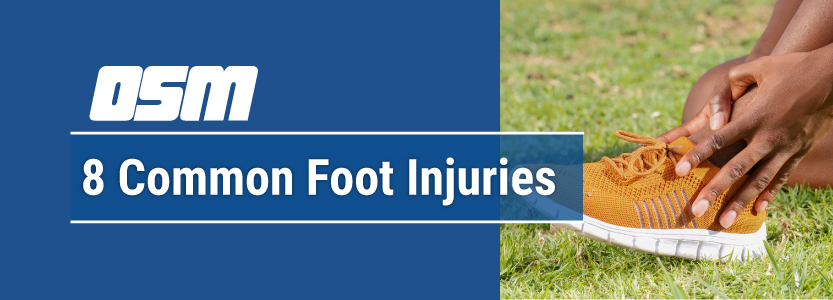Article featured on Healthgrades
What to Know About Foot (and Ankle) Injuries
Inside your foot lies machinery that would impress any engineer. A total of 26 bones, 33 joints, and more than 100 tendons, muscles and ligaments work in tandem to support your weight and propel you through your daily routine. Just as the highest-tech machine can malfunction, flaws in the inner workings of your feet—or overwhelming demands from the outside—can cause injuries. Here are eight problems that can strike your feet, along with solutions.
1. Neuromas
Too-tight or high-heeled shoes, among other causes, can compress the nerves between your toes. Most often, this occurs between your third and fourth toes, a condition called Morton’s neuroma. The pain, tingling, and numbness of a neuroma can often be relieved with padding, icing, orthotics, and wearing shoes with a wide toe box and low heels.
2. Stress Fracture
Among the more severe sports injuries, stress fractures often occur when you overdo a high-impact activity like running, dance or basketball. Fatigued muscles transfer stress to the bone. A small, hairline crack forms, causing potentially severe pain. Though stress fractures can occur in any part of your foot, they most often form in the second and third metatarsals, or long toe bones. Rest allows your bones to heal, usually in 6 to 8 weeks.
3. Plantar Fasciitis
Does the first step out of bed in the morning have you howling in pain? You likely have plantar fasciitis, an inflammation of the band of tissue—facscia—connecting your toes to your heel on the bottom of your foot. High-impact sports, extra weight, and jobs that require walking or standing on hard surfaces increase your risk. Stretch your foot and calf frequently, and consider wearing a night splint that lengthens your plantar fascia while you sleep.
4. Heel Spurs
Heel spurs occur when calcium deposits build up on the bottom of your heel bone. Often, they don’t cause pain themselves—but they can irritate the plantar fascia, triggering pain along the arch and heel. Calf and foot stretches work well to relieve it; rarely is surgery to remove the spur necessary.
5. Bunions
This bump of bone and tissue at the base of your big toe forms when the joint connecting it to your foot shifts out of place. Narrow-toed and high-heeled shoes cause most cases, though heredity plays a small role. Left untreated, bunions can cause pain so severe it limits your ability to walk. Fortunately, treatments like ice, over-the-counter foot pads, and wearing shoes with wider toe boxes often bring relief.
6. Sesamoiditis
Your sesamoids—two pea-shaped bones lodged in the tendon beneath the ball of your foot—help the big toe move normally. Activities that place strain on the ball of the foot, including running and golf, can injure the bones, tendons, or surrounding tissue. Padding, strapping, or taping the foot can relieve pressure on the sesamoids, while anti-inflammatory drugs reduce pain and swelling.
7. Achilles Tendinitis
The lengthy Achilles tendon can grow thick, inflamed, swollen or painful when asked to do too much, too soon (for example, after beginning an ambitious exercise program). Tight calf muscles may also play a role. Often, pain decreases after switching from a high-impact exercise to a cross-training program, such as biking, elliptical or swimming, paired with moves to stretch and strengthen the calves.
8. Ankle Sprains
About 25,000 people fall, step or twist their way into an ankle sprain each day. This common injury occurs when the ligaments on the outer side of your ankle stretch or tear, causing pain, swelling, and sometimes an inability to bear weight. Talk with a doctor if that’s the case, or if you have severe swelling or deformity. For mild sprains, rest, ice, compression and elevation—the RICE protocol—usually does the trick.
The Orthopedic & Sports Medicine Center of Oregon is an award-winning, board-certified orthopedic group located in downtown Portland Oregon. We utilize both surgical and nonsurgical means to treat musculoskeletal trauma, spine diseases, sports injuries, degenerative diseases, infections, tumors and congenital disorders.
Our mission is to return our patients back to pain-free mobility and full strength as quickly and painlessly as possible using both surgical and non-surgical orthopedic procedures.
Our expert physicians provide leading-edge, comprehensive care in the diagnosis and treatment of orthopedic conditions, including total joint replacement and sports medicine. We apply the latest state-of-the-art techniques in order to return our patients to their active lifestyle.
If you’re looking for compassionate, expert orthopedic surgeons in Portland Oregon, contact OSM today.
Phone:
503-224-8399
Address
17355 Lower Boones Ferry Rd Suite 100A
Lake Oswego, OR 97035
Hours
Monday–Friday
8:00am – 4:30pm



